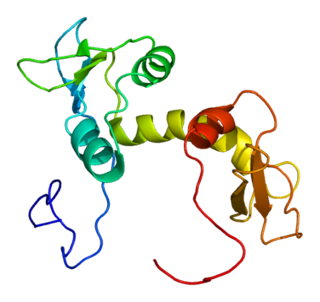Eukaryotic translation initiation factor 3 subunit D (eIF3d) is a protein that in humans is encoded by the EIF3D gene. [5] [6]
Eukaryotic translation initiation factor 3 subunit D (eIF3d) is a protein that in humans is encoded by the EIF3D gene. [5] [6]
Eukaryotic translation initiation factor-3 (eIF3), the largest of the eIFs, is a multiprotein complex composed of at least ten nonidentical subunits. The complex binds to the 40S ribosome and helps maintain the 40S and 60S ribosomal subunits in a dissociated state. It is also thought to play a role in the formation of the 40S initiation complex by interacting with the ternary complex of eIF2/GTP/methionyl-tRNA, and by promoting mRNA binding. The protein encoded by this gene is the major RNA binding subunit of the eIF3 complex. [6]
EIF3D has been shown to interact with PHLDA1 [7] and EIF3A. [8] [9] [10]
EIF3D has also been shown to interact with c-Jun mRNA via a non-canonical mechanism. Instead of the EIF4G protein acting as a cap-binding protein to mediate translation, EIF3D has been shown to be a cap binding protein for certain mRNAs such as c-Jun which has structures at the 5' UTR inhibiting binding of EIF4G and promoting binding of EIF3D. [11] EIF3D as a cap binding protein has been thought of as critical to regulating gene expression under cell stress such as during glucose deprivation. For translation of c-Jun under glucose starved conditions, the cap binding activity of EIF3D increased by 10-fold. [12] [13]
Eukaryotic initiation factors (eIFs) are proteins or protein complexes involved in the initiation phase of eukaryotic translation. These proteins help stabilize the formation of ribosomal preinitiation complexes around the start codon and are an important input for post-transcription gene regulation. Several initiation factors form a complex with the small 40S ribosomal subunit and Met-tRNAiMet called the 43S preinitiation complex. Additional factors of the eIF4F complex recruit the 43S PIC to the five-prime cap structure of the mRNA, from which the 43S particle scans 5'-->3' along the mRNA to reach an AUG start codon. Recognition of the start codon by the Met-tRNAiMet promotes gated phosphate and eIF1 release to form the 48S preinitiation complex, followed by large 60S ribosomal subunit recruitment to form the 80S ribosome. There exist many more eukaryotic initiation factors than prokaryotic initiation factors, reflecting the greater biological complexity of eukaryotic translation. There are at least twelve eukaryotic initiation factors, composed of many more polypeptides, and these are described below.

Eukaryotic translation initiation factor 3 subunit E (eIF3e) is a protein that in humans is encoded by the EIF3E gene.

Eukaryotic translation initiation factor 2 subunit 1 (eIF2α) is a protein that in humans is encoded by the EIF2S1 gene.

Eukaryotic translation initiation factor 6 (EIF6), also known as Integrin beta 4 binding protein (ITGB4BP), is a human gene.

Eukaryotic translation initiation factor 3 subunit A (eIF3a) is a protein that in humans is encoded by the EIF3A gene. It is one of the subunits of Eukaryotic initiation factor 3 (eIF3) a multiprotein complex playing major roles in translation initiation in eukaryotes.

Eukaryotic translation initiation factor 2 subunit 2 (eIF2β) is a protein that in humans is encoded by the EIF2S2 gene.

Eukaryotic translation initiation factor 3 subunit I (eIF3i) is a protein that in humans is encoded by the EIF3I gene.

Eukaryotic translation initiation factor 4B is a protein that in humans is encoded by the EIF4B gene.

Eukaryotic translation initiation factor 3 subunit B (eIF3b) is a protein that in humans is encoded by the EIF3B gene.

Eukaryotic translation initiation factor 3 subunit C (eIF3c) is a protein that in humans is encoded by the EIF3C gene.

Eukaryotic translation initiation factor 3 subunit H (eIF3h) is a protein that in humans is encoded by the EIF3H gene.

Eukaryotic translation initiation factor 5 is a protein that in humans is encoded by the EIF5 gene.

Eukaryotic translation initiation factor 3 subunit G (eIF3g) is a protein that in humans is encoded by the EIF3G gene.

Eukaryotic translation initiation factor 3 subunit F (eIF3f) is a protein that in humans is encoded by the EIF3F gene.

Eukaryotic translation initiation factor 3 subunit J (eIF3j) is a protein that in humans is encoded by the EIF3J gene.

Eukaryotic translation initiation factor 1 (eIF1) is a protein that in humans is encoded by the EIF1 gene. It is related to yeast SUI1.

Eukaryotic translation initiation factor 3 subunit K (eIF3k) is a protein that in humans is encoded by the EIF3K gene.
The eukaryotic initiation factor-4A (eIF4A) family consists of 3 closely related proteins EIF4A1, EIF4A2, and EIF4A3. These factors are required for the binding of mRNA to 40S ribosomal subunits. In addition these proteins are helicases that function to unwind double-stranded RNA.

Eukaryotic initiation factor 3 (eIF3) is a multiprotein complex that functions during the initiation phase of eukaryotic translation. It is essential for most forms of cap-dependent and cap-independent translation initiation. In humans, eIF3 consists of 13 nonidentical subunits (eIF3a-m) with a combined molecular weight of ~800 kDa, making it the largest translation initiation factor. The eIF3 complex is broadly conserved across eukaryotes, but the conservation of individual subunits varies across organisms. For instance, while most mammalian eIF3 complexes are composed of 13 subunits, budding yeast's eIF3 has only six subunits.

Eukaryotic initiation factor 4F (eIF4F) is a heterotrimeric protein complex that binds the 5' cap of messenger RNAs (mRNAs) to promote eukaryotic translation initiation. The eIF4F complex is composed of three non-identical subunits: the DEAD-box RNA helicase eIF4A, the cap-binding protein eIF4E, and the large "scaffold" protein eIF4G. The mammalian eIF4F complex was first described in 1983, and has been a major area of study into the molecular mechanisms of cap-dependent translation initiation ever since.